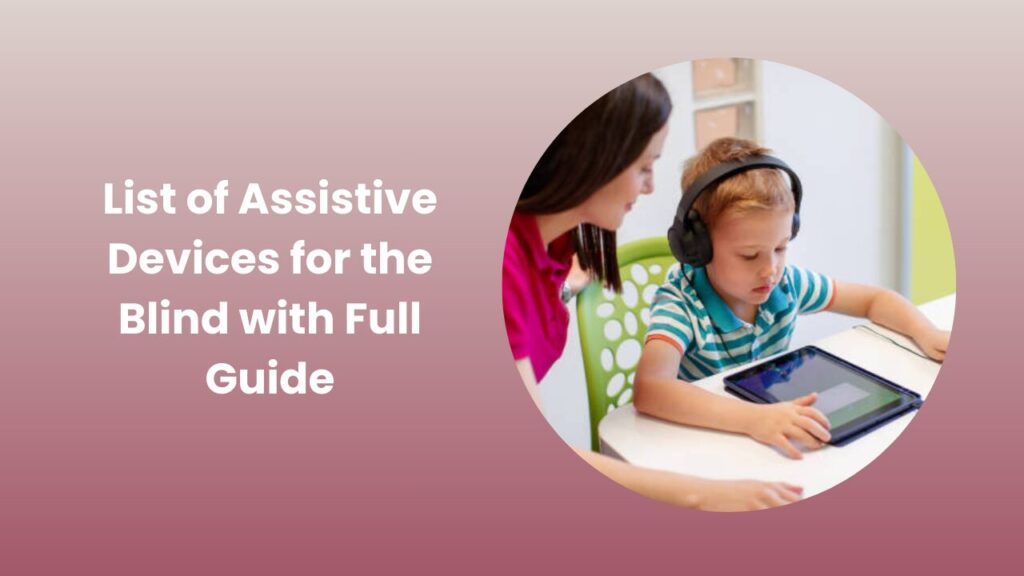Living with blindness or severe vision impairment presents unique challenges in everyday life, but modern technology and innovation have made it possible for individuals to maintain independence, enhance communication, and improve overall quality of life. From navigation aids to digital reading devices, the world of assistive technology has expanded in remarkable ways. In this guide, we will provide a comprehensive list of assistive devices for the blind, explaining how each one works and the role it plays in supporting accessibility. This article will not only introduce various tools but also highlight their practical benefits, making it easier for readers to understand the importance of assistive devices in building an inclusive society.
Understanding Assistive Devices for the Blind
Assistive devices are specially designed tools and technologies that bridge the gap between vision impairment and everyday functionality. They range from simple tactile solutions like braille displays to advanced AI-powered smart glasses. The purpose of these devices is to promote independence by offering alternatives to sight-based interactions. Over the years, innovations in digital technology have transformed accessibility solutions, making them more user-friendly, portable, and affordable. As we move further into the digital age, the assistive devices for the blind continue to expand, creating greater opportunities for independence, learning, and inclusion.
The Role of Assistive Technology in Daily Life
For someone who is blind or visually impaired, daily tasks such as reading, commuting, or using a smartphone can become overwhelming without support. Assistive technology helps minimize these barriers. Devices are designed not only for personal use but also for education, employment, healthcare, and entertainment. The shift toward smart technology has also given rise to voice-controlled assistants, mobile apps, and wearable gadgets that make accessibility more seamless. By understanding each device in detail, one can better appreciate how these tools help people lead more empowered lives.
List of Assistive Devices for the Blind
Braille Displays
Braille displays are electronic devices that convert digital text into tactile braille characters. Users can run their fingers across a series of small pins that rise and fall to form letters and numbers. These displays allow blind individuals to read digital content from computers, tablets, and smartphones in real time. Many modern braille displays also include features such as note-taking, bookmarking, and direct internet connectivity, making them essential for education and professional work. They ensure that braille literacy remains relevant in the digital era.
Screen Readers
Screen readers are software programs that convert on-screen text into synthesized speech or braille output. They enable users to interact with digital devices, websites, and applications through audio cues. Popular screen readers like JAWS, NVDA, and VoiceOver have revolutionized digital accessibility, making it possible for blind users to access email, browse the internet, and use productivity tools independently. The intuitive design of these programs has made them a cornerstone in modern accessibility.
Smart Glasses for the Blind
Smart glasses are wearable devices equipped with cameras, sensors, and artificial intelligence. These glasses help blind individuals recognize objects, read printed text, and even identify faces through audio feedback. Some advanced models integrate GPS technology to provide navigation assistance. The rise of AI-powered smart glasses has significantly expanded independence, allowing users to engage more confidently in outdoor environments, workplaces, and social settings.
Digital Voice Recorders
Digital voice recorders provide a simple yet powerful way for blind individuals to capture notes, reminders, and important information. These devices are often used by students, professionals, and anyone who wants an efficient way to organize thoughts without relying on written text. Many recorders also feature voice labeling, file categorization, and playback speed control, ensuring that users can quickly access stored information.
Talking Watches and Clocks
Telling time is something most people take for granted, but for blind individuals, accessible solutions are crucial. Talking watches and clocks announce the time through a clear voice output, ensuring users can keep track of their schedules. Some advanced versions even include alarms, temperature readings, and calendar functions. These devices promote independence by helping individuals manage daily routines without depending on others.
Portable Magnifiers
Although primarily used by individuals with low vision, portable magnifiers are also useful for those with partial blindness. These electronic magnifiers enlarge text, images, and objects, displaying them on a screen for easier viewing. Many magnifiers now include features such as color contrast adjustment, freeze-frame, and text-to-speech functions. They are particularly helpful in academic and professional environments where detailed reading is required.
GPS Navigation Devices
Navigation poses one of the biggest challenges for people with vision loss. GPS navigation devices designed for the blind provide real-time directions through voice output, helping users move independently in unfamiliar environments. These devices go beyond standard GPS by offering information about crosswalks, bus stops, and landmarks. Some are available as standalone devices, while others function as smartphone applications.
Electronic Braille Notetakers
Electronic braille notetakers combine the functionality of a braille display with note-taking and productivity features. They allow users to write, edit, and store notes in braille while also offering tools like email access, calendars, and word processing. These devices are especially beneficial for students and professionals who need an all-in-one tool for both reading and writing in braille.
Audio Book Players
Access to literature and learning materials is essential, and audio book players make this possible for blind individuals. These devices allow users to listen to books, magazines, and academic materials in audio format. Many support navigation features like bookmarking, variable playback speeds, and voice-controlled search. By offering an accessible alternative to print, audio book players ensure equal opportunities for education and leisure.
Refreshable Tactile Graphics Displays
In addition to braille text, tactile graphics displays provide access to diagrams, charts, and maps. These devices use raised surfaces that change dynamically to represent different shapes and patterns. They are particularly useful in educational fields like science, mathematics, and geography, where visual information is crucial. By making graphic content accessible, tactile displays open new possibilities in advanced learning.
Voice Assistants and Smart Speakers
Devices like Amazon Echo and Google Nest have become invaluable tools for blind users. With simple voice commands, individuals can control household appliances, set reminders, play music, and access information online. These voice assistants integrate seamlessly with other smart devices, creating a fully accessible home environment. Their growing popularity reflects the importance of AI-driven accessibility solutions.
Electronic Mobility Canes
Electronic canes enhance traditional white canes with added features such as obstacle detection, GPS navigation, and vibration alerts. These advanced tools provide real-time feedback about the user’s surroundings, making travel safer and more efficient. Some electronic canes also connect to smartphones, offering additional functionality such as mapping and route planning. They represent a powerful blend of traditional mobility tools and modern technology.
Reading Machines
Reading machines are standalone devices that scan printed materials and convert them into spoken words. They are particularly helpful for reading newspapers, letters, and printed documents. Some advanced models now integrate with smartphones and computers, allowing for more flexible use. By turning print into speech, these machines ensure that information remains accessible to blind individuals in various settings.
Wearable Haptic Devices
Wearable haptic devices use vibrations and tactile feedback to convey information. They can be worn on the wrist or other parts of the body and are often used for navigation or receiving alerts. By replacing auditory signals with tactile ones, these devices provide discreet and efficient ways for blind users to access information. They are especially useful in noisy environments where audio cues may be harder to detect.
The Growing Importance of Assistive Devices
The range of assistive devices for the blind continues to grow as technology advances. From traditional braille tools to cutting-edge AI wearables, these devices empower individuals to navigate life with greater independence. Accessibility is no longer a limited concept; it has become a global movement backed by innovation, legislation, and inclusivity. The constant expansion of the assistive devices for the blind highlights the ongoing commitment to creating equal opportunities for everyone, regardless of their visual abilities.
FAQs
What are the most commonly used assistive devices for the blind?
Commonly used devices include braille displays, screen readers, talking watches, audio book players, and electronic canes. These tools provide essential support for reading, navigation, and daily tasks.
Are assistive devices for the blind expensive?
Prices vary widely depending on the device. While some options like talking clocks are affordable, advanced devices such as smart glasses or braille notetakers can be expensive. However, organizations and government programs often provide support to make them more accessible.
Can smartphones replace assistive devices for the blind?
Smartphones equipped with accessibility features and apps can replace some assistive devices, such as GPS navigation tools or digital recorders. However, specialized devices like braille displays and tactile graphics systems remain irreplaceable for certain tasks.
How do assistive devices improve education for the blind?
Assistive devices provide access to textbooks, research material, and classroom participation. Tools like braille notetakers, tactile displays, and audio book players make learning environments more inclusive and effective.
What is the future of assistive technology for the blind?
The future lies in artificial intelligence, wearable technology, and greater integration with mainstream devices. Innovations are moving toward more affordable, portable, and user-friendly solutions that expand independence and accessibility.
Conclusion
Assistive devices for the blind have transformed lives by promoting accessibility, independence, and confidence. From traditional braille systems to advanced AI-powered wearables, the variety of tools available today ensures that individuals with vision loss can fully participate in education, employment, and daily activities. As technology continues to evolve, the list of assistive devices for the blind will only grow, creating even more opportunities for empowerment. These innovations remind us that inclusion is not just a concept but a responsibility, one that can be achieved through continuous commitment to accessibility.





